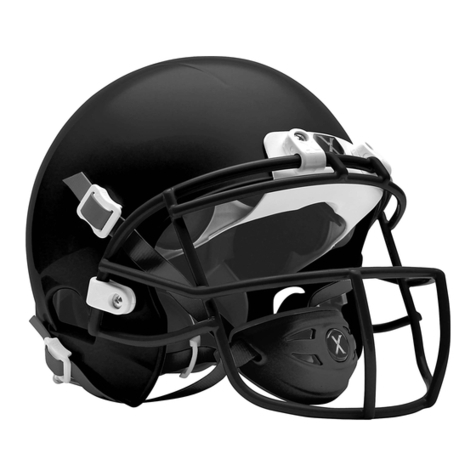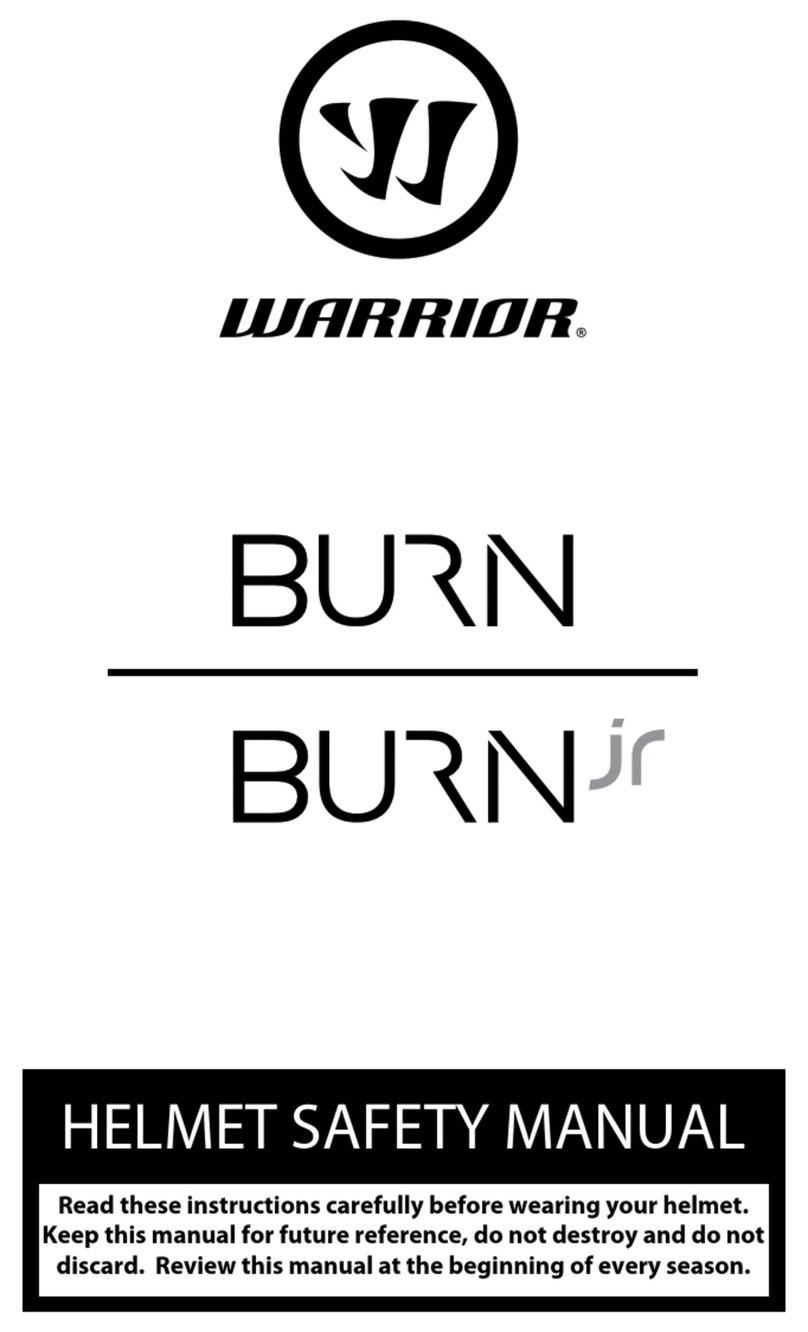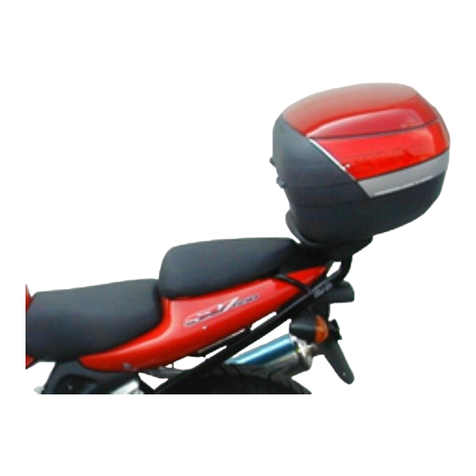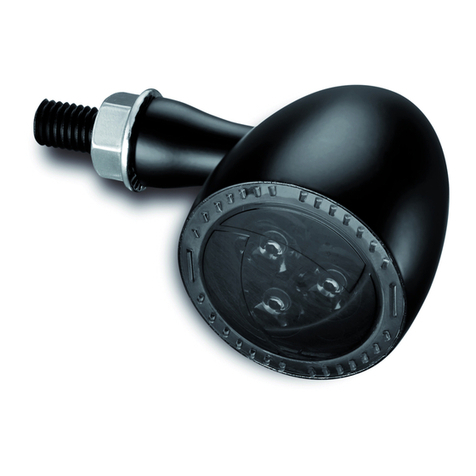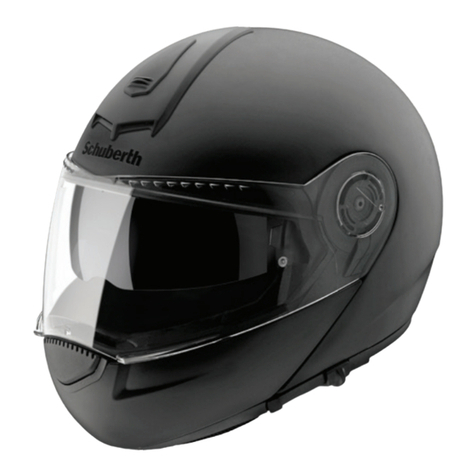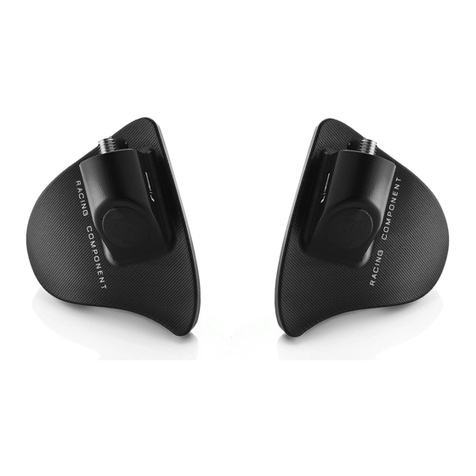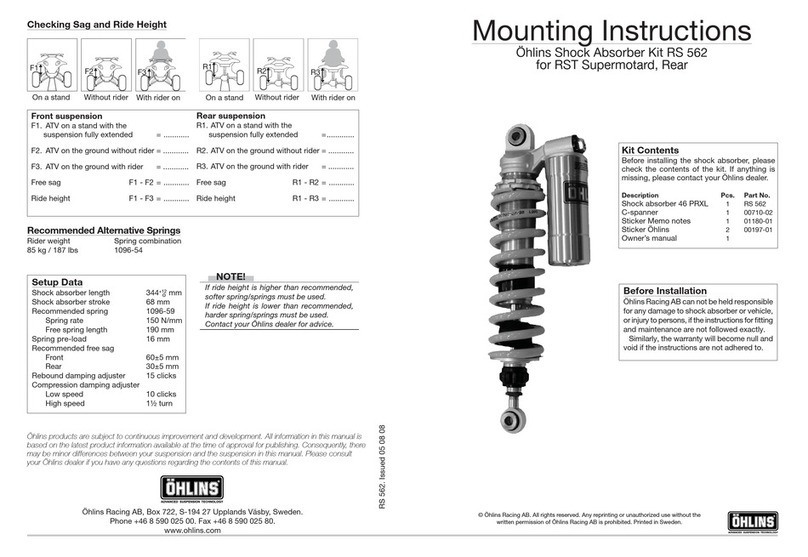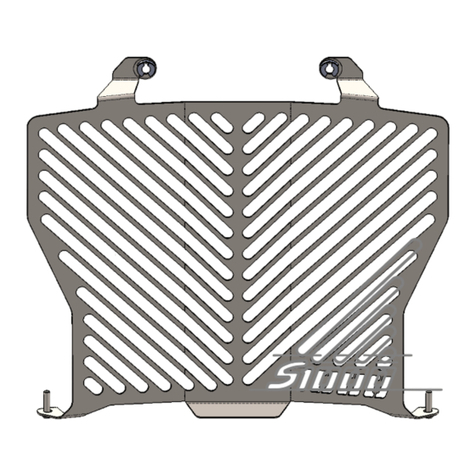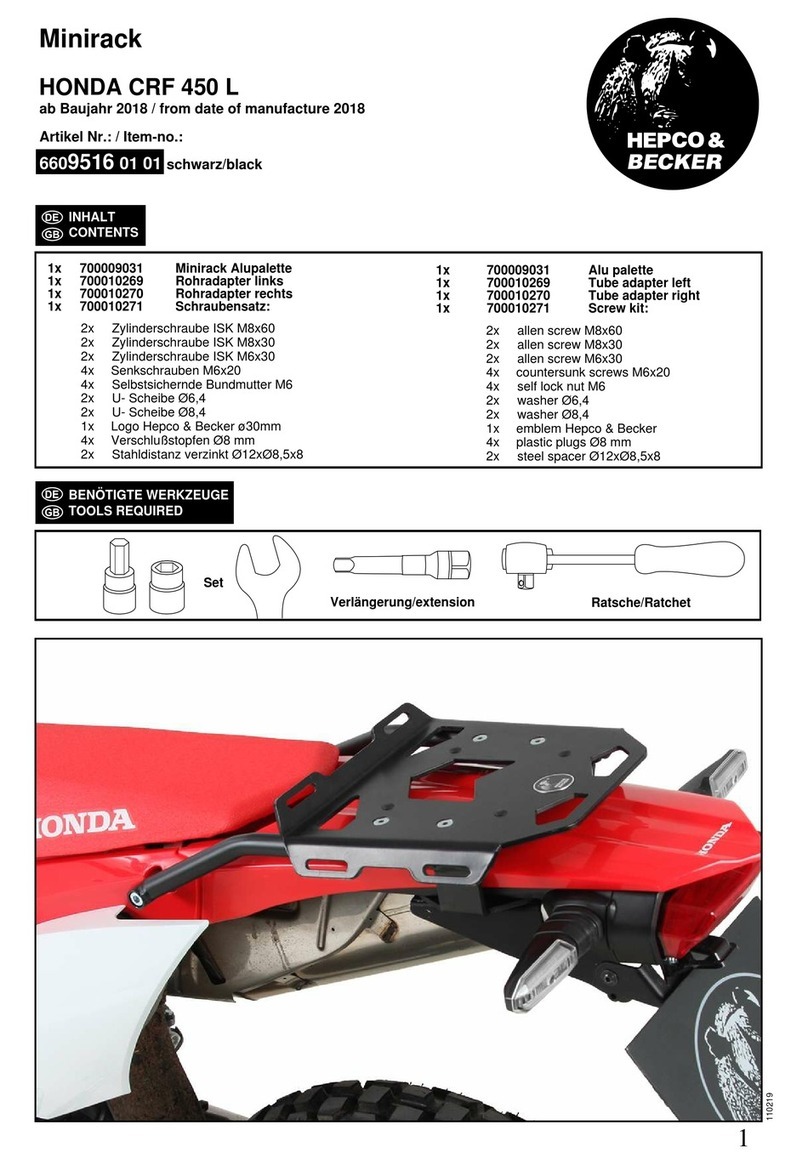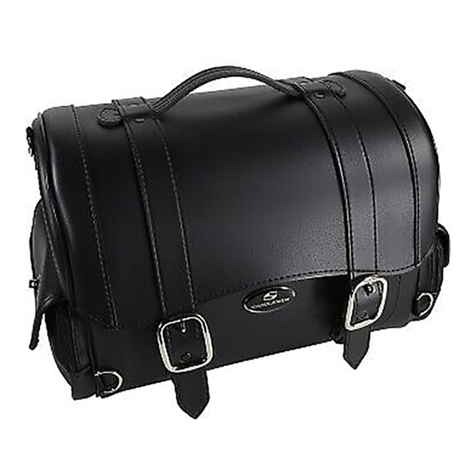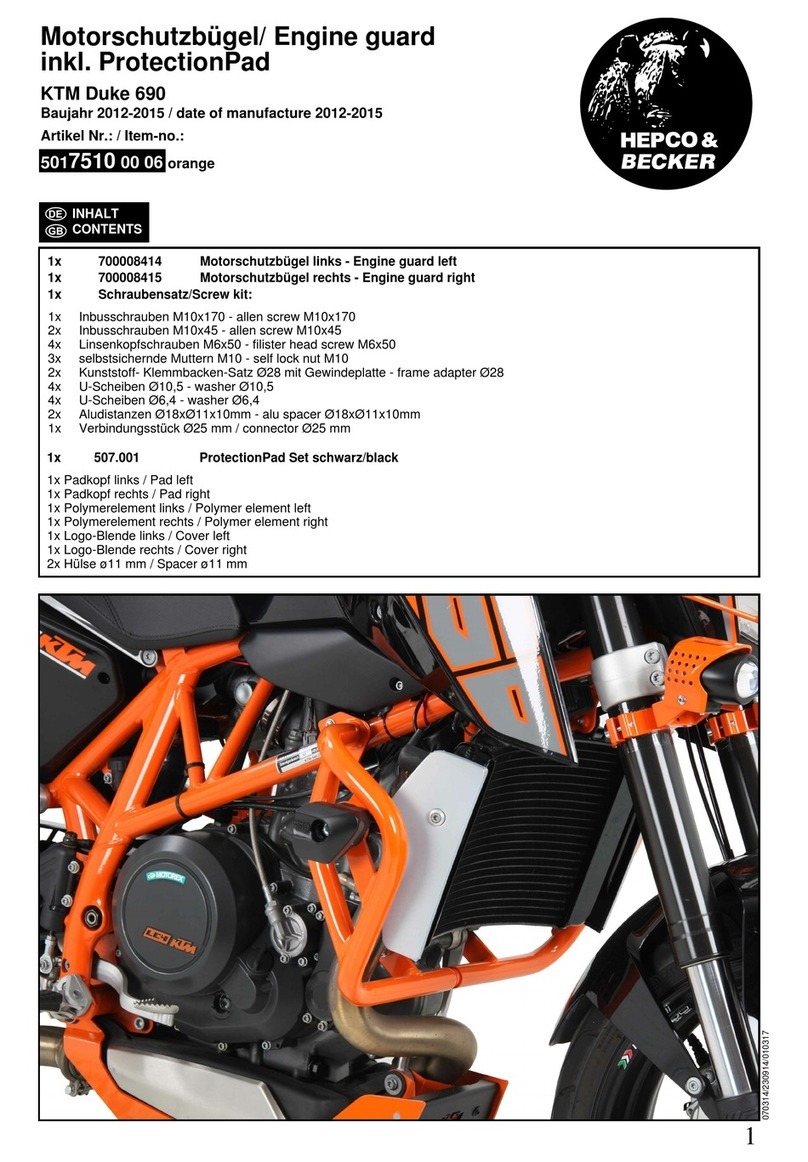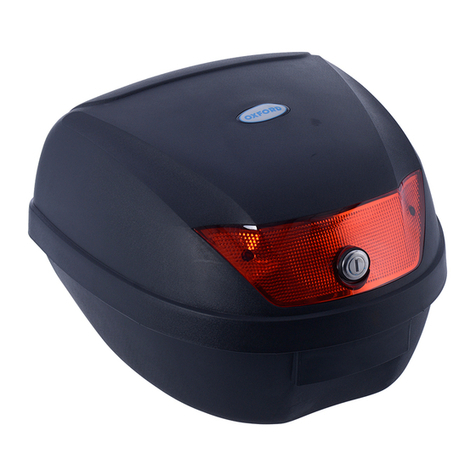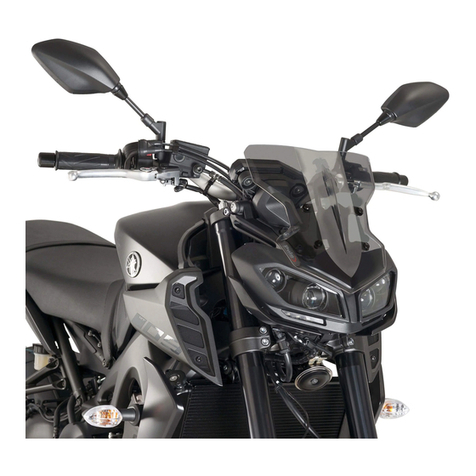Third Eye inView Assembly instructions

Third Eye inViewTM Installation Guide and User Manual v181206 1 | Page
Third Eye inViewTM Installation Guide and User Manual
A quick look at Third Eye inViewTM
Congratulations! You now own one of the most significant advances in motorcycle
safety. Studies from around the globe prove what we already know - motorcyclists get
hit because they are not seen. Third Eye inViewTM was designed to improve your
visibility by placing a brake and turn signal light where is it most visible –high and center.
Two patents provide a rich feature set and once installed, Third Eye inViewTM requires almost no user
intervention.
Key features include:
Brake, Turn Signal and Hazzard light functionality
•Technology so efficient it doesn’t need an on/off switch
•Automatic diagnostics that test function, LEDs and battery life
•Integration with the motorcycle braking and directional systems for consistent signaling
•Deceleration (down shifting) illuminates helmet light and accessory tail light (coming 2019)
•Ultra-bright LEDs –for daytime visibility
•Long battery life - utilizes common Lithium-ion AAA, easily replaced batteries
•Easily transferred between helmets
•Do-it-yourself installation
Third Eye Design was founded on the belief that we can make this world a better, safer place –thanks
for helping us do this, one motorcycle at a time! The Third Eye inView™ wireless helmet brake and turn
signal light system is patent pending in the United States and worldwide.

Third Eye inViewTM Installation Guide and User Manual v181206 2 | Page
PLEASE READ BEFORE INSTALLING Third Eye Design products should be installed by a qualified,
experienced motorcycle technician. If you are unsure of your ability to properly install a product,
please have the product installed by your local motorcycle dealer. Third Eye Design takes no
responsibility for damages caused by improper installation.
INCOMPATABILITY WITH INDIAN MOTORCYCLES -- PLEASE NOTE: Indian motorcycles use a constant
positive signal and ECU flashed negative to control brake and turn signals. This is opposite of how
other motorcycles control brake and signal light activation. inViewTM does not currently work with
this system. A firmware update will address this in the spring.
Package Contents
(2) 3M Dual-LockTM disks (to attach the helmet
brake and signal light
(2) Posi-LockTM connectors (accessory brake light)
(4) Posi-TapTM connectors (left directional, right
directional, brake, ignition-on)
(1) 3M Double-sided foam mounting tape (to
attach the motorcycle transceiver unit)
(1) Transceiver unit
(2) AAA batteries
(2) FuseTM
(1) Accessory brake light
(3) Alcohol prep pads
(1) Receiver Unit
(1) Double-sided mounting tape (to attach the
accessory brake light)
Installation Overview
These instructions are written to help guide you in installing the Third Eye inViewTM brake and turn
signal system. There are three parts to these instructions:
I. Part one (I) explains how to install the wireless sending unit onto the motorcycle (transceiver
unit).
II. Part two (II) explains how to install the accessory brake light onto the motorcycle
III. Part three (III) explains how to affix the wireless brake and turn signal LED assembly (receiver
unit) onto the helmet.
IMPORTANT: Once installed, please update both the motorcycle and helmet units with the latest
firmware! Full instructions and firmware can be found on our support page:
https://thirdeyedesigninc.com/support/

Third Eye inViewTM Installation Guide and User Manual v181206 3 | Page
Installation Precaution Notice - Please read the following instructions thoroughly before installing
the motorcycle transceiver and helmet receiver units.
NOTE: These instructions are written for a person who has a good understanding of motorcycle
maintenance - both electrical and mechanical. You must be comfortable in removing a seat, service
covers or other motorcycle parts to expose your motorcycle’s wiring. Additionally, you must have a
good understanding of your motorcycle’s wiring so you can locate the brake wire, right and left turn
signal wires, and the power and ground wires.
NOTE: If at any time during the installation process you feel uncomfortable in performing the tasks
documented in these instructions, please consult an authorized motorcycle service center in your area
for help.
I. Part One: Mounting and Connecting the Motorcycle Transceiver Unit
Required Components:
(1) Transceiver unit
(1) 3M Double-sided foam mounting tape
(3) Posi-TapTM connectors
(1) Alcohol prep pad
•Wiring diagrams and schematics as
needed (many are located here:
http://www.classiccycles.org/)
•Required tools to access your motorcycle
battery, mounting location and electrical
components
Before beginning the installation, take a look at the small motorcycle transceiver box that has the seven
colored wires coming out of it. Locate space on the motorcycle that is large enough to safely house this
box and its wires. The location must be positioned where the unit is protected from physical harm.
While the unit is resistant to moisture, it should be located in a place where it is not exposed to water
or excessive heat. Also consider that it is best if the location is not obscured by large metal surfaces
which can interfere with signal transmission.
Wiring Instruction for the Motorcycle Transceiver Unit
When wiring the motorcycle transceiver please remember to always test all the functions of the
transceiver and ensure that the helmet lights function properly before cutting the wire leads to length
and securing the transceiver to the motorcycle.

Third Eye inViewTM Installation Guide and User Manual v181206 4 | Page
Note: The wiring taps (see Quick & Easy usage diagram below) supplied with your unit can be easily
moved and reused until you are satisfied with your
installation.
1. Find a safe, secure, and dry place to mount the transceiver
box. We recommend mounting it under the seat or in the
tail section if available. The clear translucent cover will allow
you to see the power and signal LEDs inside the case that
tell you that you have made a proper connection.
2. Lay out the Third Eye inViewTM transceiver the way it will be
installed onto your motorcycle. Review wire connections in
steps 4-6 and make sure the wires are routed in such a way
that they will not be pinched, cut, or exposed to direct heat or moving parts. If a power wire is
pinched it could cause the transceiver to malfunction.
3. Once the transceiver and wires are staged, clean the proposed transceiver mounting surface with
an alcohol prep pad (included). The mounting surface should be between 45 and 85 degrees
Fahrenheit to achieve the strongest bonding results from the double-sided adhesive.
Note: The surface area must be free of all oils, moisture, dirt and wax in order for the supplied
adhesive tape to bond and adhere to the installation surface correctly. Mount the transceiver to
your selected location with the double-sided 3M foam tape.
4. Next, locate the wire marked POWER IN GND on the transceiver and attach it to ground, typically a
bolt that fastens to the motorcycle’s frame. Note: Use caution that you do not pick a metal
surface that is electrically insulated by plastic or rubber bushings. (The following steps require
the use of Posi-Tap and Posi-Lock connecters per diagram below see detailed instructions here:
https://www.posi-products.com/instructions1.html )
5. Find the motorcycle transmitter wire labeled “brake input”and attach it to the motorcycle wire that
provides signal when the brake is engaged
and the brake light is illuminated. Do not
confuse the brake wire with the tail light
running light wire (which is always on when
the motorcycle is running).
6. Next, using the enclosed Posi-TapTM
connector, attach the wire labeled “right
turn” to the motorcycle wire leading to the

Third Eye inViewTM Installation Guide and User Manual v181206 5 | Page
right turn signal that is “hot”(on) only when the right turn signal is engaged and blinking.
Please note: Some motorcycles have combination brake and turn signals (eg. Harley Davidson
Street Glide) where the same tail light that is used for a running light is also used for a brake light.
The inView motorcycle transceiver must have a connection to a single input source. The input
wire cannot serve both as a brake and turn signal. If this is the case, you may need to pick up turn
signal input from the front turn signals.
7. Repeat step 6 above for the left turn signal.
8. Last, connect the power wire labeled 12V + IN directly to a switched wire that is “hot” (on) when
the motorcycle is on. Generally, good sources of power are switched accessory power outlets.
Please consult your motorcycle manual or electrical diagram. If such a wire is not readily available,
you can connect directly to the positive terminal on the battery. Once the wire is connected, install
the supplied fuse and check to make sure the power LED is illuminated when the motorcycle is on.
Note: once the fuse is installed, an LED will illuminate in the motorcycle transceiver to indicate a
proper power/ground connection and each time a signal is seen from a directional or brake (you will
see the LEDs illuminate through the clear cover. When the unit initially powers on, it will perform
self-diagnostics and all LEDs will illuminate).
9. Test to make sure that each transmitter LED glows when brake, left directional and right directional
are activated. The power LED should remain on whenever the unit is connected and power is
supplied.
10. Make sure you have proper clearances before reinstalling any covers or seats. Replace any parts
of the motorcycle that were removed.
Installation Tip: If any of the wires need to be extended, be sure to use equivalent gauge or
heavier automotive grade wire. If you are running wire and must go through the frame or any
other metal parts, make sure to protect the wire by using a grommet or electrical tape.
II. Part Two: Mounting and Connecting the Accessory Brake Light
Required Components:
•(1) Accessory brake light
•(1) Double sided mounting tape
•(2) Posi-LockTM connectors

Third Eye inViewTM Installation Guide and User Manual v181206 6 | Page
•(1) Alcohol prep pad
•Required tools to run the accessory brake
light wires to the transmitter box.
Before beginning the installation, take a look at the accessory brake light included with the Third Eye
inViewTM system. This light is mounted with the enclosed 3MTM double-sided tape. From the back of
the motorcycle, locate a suitable flat area, close to the motorcycle tail light, parallel to the ground to
mount the light. The best locations are typically above or below the existing tail light. Once mounted,
the light must face directly backwards and should not be angled up or down. The accessory brake light
functions when the Third Eye inViewTM transmitter senses deceleration and sends a signal
simultaneously to the accessory brake light and helmet light. This insures following motorists see (and
understand) the relationship between the helmet light and the motorcycle accessory brake light
1. After identifying a suitable location, determine a clear path to route the wires to connect them
to the 12V Power Out wires from the transceiver unit installed in the motorcycle.
2. Connect the accessory brake light to the motorcycle transceiver’s 12V Power Out wires using the
Posi-LockTM connectors.
3. Secure the wires with the enclosed tie-wraps or electrical
tape as necessary.
III. Part Three: Mounting the Helmet Receiver Unit
Required Components:
•(1) Helmet brake and signal light
•(1) 3M Dual-lockTM mounting tape
•(2) AAA batteries
•(1) Alcohol pad
Instructions for Installing the Helmet Receiver Unit
Note: Installation of the helmet receiver unit is only for those helmets whose outer shell is a
hard polycarbonate or similar shell.
1. Install the batteries by removing the 2 screws on the base of the helmet receiver unit and
carefully pull the base and skirt away from the lens assembly.
NOTE: Be sure to install the batteries with correct polarity (as indicated).

Third Eye inViewTM Installation Guide and User Manual v181206 7 | Page
Please note: Do not overtighten the screws! Just 3 inch-pounds of force (a gentle, finger tight)
is necessary to tighten the back against the skirt gasket.
2. Locate one of the 3M Dual-lockTM tape coins. With the adhesive side out and the protective tape
in place, pinch the coin to the back of the helmet receiver’s pre-installed 3M Dual-lockTM so that
you have (2) pair of coins connected by the Dual-lockTM fastener.
3. Locate the area on the back of the helmet where you wish to install the helmet receiver base.
The area should be smooth and clean. Without removing the protective tape to expose the
adhesive, align the helmet receiver in the best location on the back of the helmet. When wearing
the helmet in a normal riding position, the helmet receiver unit should point straight back. Test
the area to ensure that the Dual-lockTM tape coin makes good contact and the flexible skirt fills
he gap as best as possible. This is a good time to have someone help you pick the best spot on
the helmet –it may be higher than you think. Please test the unit to insure the turn signals are
correctly oriented!
Installation Tip:
•The helmet receiver must be applied so that the logo and writing on the base is right-side
up. If installed upside down, it will beep and flash continuously, when it initially connects to
the motorcycle to indicate that it is upside down. This test only occurs once each time it
connects to the motorcycle. Note: Be careful not to remove and reinstall the helmet unit
while the motorcycle is running since the test will not be performed until the unit reconnects
to the motorcycle the next time it is started.
•The 3M Dual-lockTM tape should be applied directly to the helmet surface and not over decals
or vents. The helmet and tape must be at room temperature. Once you have the area
selected, use masking tape to mark reference points where the top, bottom and sides of the
base will be on the helmet. This will help you properly align and attach the base.
4. Use an alcohol pad (included) to clean the mounting area on the helmet.
5. Remove the protective tape from the Dual-LockTM pads on the helmet receiver base to expose
the adhesive. Be careful not to touch the adhesive with your fingers, and ensure it is not
contaminated in any way prior to attachment to your helmet.
6. Carefully align the base to the tape markings you made (see second bullet under “Installation
Tip” above) and affix the base to the helmet.
Important: Do not attempt to remove the pads or reposition the unit for at least 3 hours after
mounting on the helmet. This allows time for the adhesive to bond correctly (note: the adhesive
actually reaches its full bonding strength 48 hours after application). Once the tape has cured,

Third Eye inViewTM Installation Guide and User Manual v181206 8 | Page
you may carefully tilt the helmet receiver unit up or down to separate it from the helmet,
reposition it, or to install it on a passenger helmet with the (supplied) extra Dual-locktm coin.
Installation Tip: The helmet receiver unit has a tested range of approximately 10 feet. If it
seems that you do not have consistent functionality when in a riding position, then the
transceiver unit attached to the motorcycle may be blocked or affected by its location. Try
relocating the transceiver unit or repositioning it to increase antenna gain.
General use and care:
Operation: Third Eye inViewTM was designed as a set and forget device that requires minimal user
intervention. Once connected, a double chirp and vibration will let you know the unit is functioning
properly. When the unit disconnects (or goes back to sleep) the unit will alert you with a single chirp
and vibration. The helmet unit should be visually inspected prior to each ride to insure it is installed
correctly and working properly.
Each time the helmet unit connects to the motorcycle transceiver, the helmet unit will perform an
inversion test to make sure it is installed correctly (and not upside down). If the helmet unit is
installed upside down, it will flash and chirp repeatedly until it is correctly oriented. This test only
occurs once each time it connects to the motorcycle. Note: Be careful not to remove and reinstall the
helmet unit while the motorcycle is running since the test will not be performed until the unit
reconnects to the motorcycle the next time it is started.
Battery Installation: When changing the batteries, please make sure the motorcycle is off and not
connected to the helmet unit. Please be sure the rubber skirt is properly in place to allow the back to
seal against it. While the back is off, avoid exposure to dust, moisture or other contaminants. Do not
overtighten the screws! Just 3 inch-pounds of force (a gentle, finger tight) is necessary to tighten the
back against the skirt gasket.
Performance tip: Third Eye inViewTM was designed for use with LI (lithium-ion) batteries which
offer better power characteristics and, as an added benefit, are lighter weight.
FCC Statement:
This device complies with part 15 of the FCC rules. Operation is subject to the following two conditions. (1) This device may not cause harmful
interference. (2) This device must accept any interference received, including interference that may cause undesired operation.
IC Statement:
This device complies with Industry Canada license-exempt RSS standard(s). Operation is subject to the following two conditions: (1) this device may
not cause interference, and (2) this device must accept any interference, including interference that may cause undesired operation of the device.
Le présent appareil est conforme aux CNR d'Industrie Canada applicables aux appareils radio exempts de licence. L'exploitation est autorisée aux
deux conditions suivantes : (1) l'appareil ne doit pas produire de brouillage, et (2) l'utilisateur de l'appareil doit accepter tout brouillage
radioélectrique subi, même si le brouillage est susceptible d'en compromettre le onctionnement.
Table of contents
